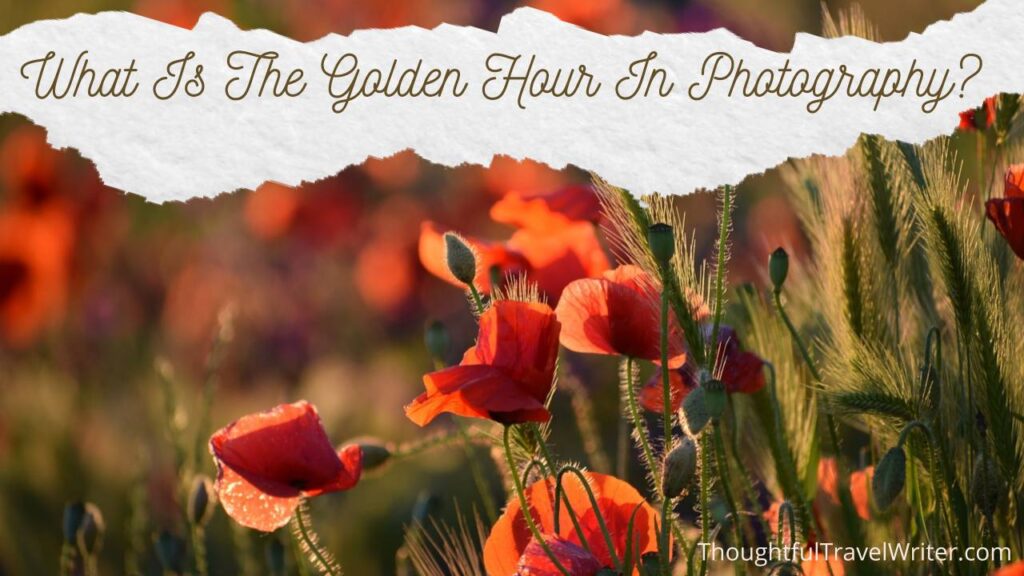What is the Golden Hour For Photographers?
What is so special about golden hour photography? When it comes to capturing images, nearly all photographers believe that the golden hour is the finest time of day to do it. Learn more about these lovely times of day to create a glow in your images. The golden hour is described as the hour preceding sunset and the hour after dawn, which are the first and final hours of daylight in the day.
The phrase “golden hour” refers to a moment when a photographer has the most opportunity. To be more exact, it is the time of day immediately following sunrise or just preceding sunset. The color of sunshine is redder and softer during this time of day than when the sun is higher in the sky. Photographers refer to this period as a “magical hour” because of the wonderful lighting conditions it affords for creating spectacular photos. The brightness of the sky correlates to the brightness of the surrounding streetlights, signage, automobile headlights, and lit windows at this moment in time. It only lasts around twenty to thirty minutes.
When does the Golden Hour begin and end?
Professional photographers consider the hour before sunset and the hour after sunrise to be the optimum periods to photograph their subjects. These intervals of time, known as “the golden hour” or “the magic hour,” give the optimum lighting conditions for creating breathtaking images. Understanding how to use the golden hour to your advantage is a skill that any photographer can benefit from understanding.
Aside from being a lovely time of day for composition, this important block of time is well recognized for providing artists with some of the most flattering natural light to work with when making amazing sunset photos. The following are some of the most successful techniques for taking advantage of Mother Nature's golden hour chance.
Suggestions for maximizing the golden hour photography
Photographers employ not just professional techniques and weather circumstances while shooting images, but also a precise time of day to completely convey their artistic goals in the shot. Lighting is one of the most important factors in determining whether or not an image will turn out nicely. You might be capturing the most gorgeous scenery or stunning figure, but your photographs will be flat, boring, and lacking of expression unless you use high-quality lighting. This is especially true when filming outside in low light circumstances where using artificial light is difficult or impossible. You will be fully reliant on natural light to finish your work in this circumstance. To mention a few, such time periods are appropriately named: a blue hour, a golden hour, or an emerald instant.
Here are some tips to help you get the most out of photographing during the golden hour: Make a strategy ahead of time. Set your camera's white balance. Use a big aperture while photographing individuals. Utilize spot metering. In the front, lighting. Backlighting. Lighting around the rim and around the borders. Flare.
These golden-hour photography tips will help you achieve the best results and create magical images
The possibilities for golden hour photography are nearly unlimited. Isn't it interesting how the identical camera settings and subject location can result in two very different photographs, even though they were shot at the same time with only a 2-3 minute exposure time difference?
Aside from following tips and strategies, experimenting with golden hour photography is the most efficient way to learn the art of golden hour photography. Remove your camera from your bag and begin shooting. Because of the compromising nature of this warm golden light, you will create some incredibly beautiful outcomes! However, it goes without saying that putting the above-mentioned ideas and tactics into practice might be useful to your job.
Various lighting options are available during the Golden hour.
There are several different lighting options to select from. What's fantastic about photography during the golden hour is that you can explore and play with various sorts of lighting all in one place. Use golden hour to snap images with natural light coming from the front. Because the light is soft enough, the models may face the sun directly, which acts as the major light source for the shoot.
Have you ever wondered how photographers acquire such lovely golden tones in their photographs? It is critical to get these sorts of photographs during the golden hour. Lighting and photographic composition are two of the most significant aspects of the profession. We're all aware that adequate lighting is vital for creating beautiful photos. By employing artificial light, your camera's flash, and even reflectors, flash photography allows you to adjust the lighting conditions in your interior photography assignments. Outdoor lighting, on the other hand, is uncontrollable, so you'll have to make do with what Mother Nature supplies.
Type of Lighting
When filming during the golden hour, you have four lighting options: backlighting, front-lighting, rim lighting, and flare lighting. Backlighting: Backlighting is performed by putting your subject with their back to the sun or light source, which usually results in a hazy effect. Is your subject look too dark? To fill up the spaces surrounding your subject, increase your exposure duration or use a reflector. Front-lighting is the polar opposite of backlighting and happens when your subject is immediately in front of the light source. This style of lighting creates the beautiful, warm, and flattering tone seen in portraiture. All you have to do is ensure that the sun is right on you!
The greatest approach to making the most of any photography opportunity is to have fun while shooting. The golden hour offers photographers an excellent atmosphere in which to experiment with various forms of lighting and produce outcomes that would be impossible to attain under any other circumstances. Some of the inventive photographic concepts you might consider implementing into your next magic hour session are listed below:
Why Do Photos Look So Good When Taken In The Golden Hour
The golden hour is easy to capture because the light is soft, warm, and directed, lighting the northern and eastern horizons. Everyone appreciates shooting photos when the sun is shining brilliantly since it is less challenging and scary. Because the sun is lower in the sky at this time of day, the golden hour seems more pensive.
When shooting pictures, the “golden hour” refers to the period of time immediately following dawn and shortly before sunset. Because the sun isn't directly above during these hours, the light is redder and softer than it is in the middle of the day. Because of the reddish, mellow light that permeates the space, golden hour is a very flattering time of day to snap pictures. In this photograph, the shadows are longer and the colors are more contrasted. For photographers, the golden hour is a common time to organize client sessions in order to take advantage of the attractive light available.
This form of illumination occurs just once or twice a day when the sun is low in the sky and closest to the earth. Evenings are the most popular times to capture portraits throughout the summer months, especially in the city.
In photography, the term “golden hour” refers to the time between dawn and sunset. Because the light is so gorgeous at this time of day, we photographers like capturing images.
What exactly is “golden hour” photography?
Many photography publications geared at new photographers claim that the only good periods to shoot are during the golden hour (also known as the blue hour), which is the period between sunrise and sunset, as well as before and after dawn or sunset. Some authors have gone so far as to state that they put their cameras away in the afternoon when the light is the worst. After that, as your photographic talents improve, you'll realize you don't have to hide your camera away like a hermit simply because the sun has risen. Any time of day is a terrific time to shoot, but my favorite is around the golden hour (harsh light is also a favorite because of the shadows it creates).
Despite the fact that it is referred to as the “hour,” the golden hour does not last exactly one hour. In general, it's a good idea to arrive at your destination before the event starts and to leave after it's finished. But, when will it happen?
It's all about the light in this case.
The golden hours are usually acknowledged to be the first hour after dawn and the last hour before dusk. The length of the golden hours, however, varies based on your geographical location and the time of year. What is it about this lighting situation that makes it so conducive to photography?
The sun's location in the sky. Because the sun is at such a low angle, it goes through more of the earth's atmosphere before impacting the subject. As a result, the light is soft, diffused, and appealing.
In this sense, what is the “golden hour”? Photographers aspire to capture these incredible, mystical photographs at an ideal dawn or sunset session. Perfected radiant skin, soft shadows, and attractive highlights — it's like something out of a fairy tale. When it comes to generating a magnificent gallery of photographs for my clients, a number of elements must be taken into account. Light is the single most critical aspect of a photographer's success.
Here's how to make the most of the warm color temperatures and gentle natural light. Make the most of this light.
Is there an optimal time of day for taking photos? That's a difficult topic to answer, but the golden hour, when the sun's light is gentle and warm while simultaneously producing lengthy shadows, is a strong contender.
Tips for taking photographs during the golden hour.
Shooting during the golden hour has various advantages. Long shadows provide you the freedom to experiment with texture and express yourself artistically. For some creative fun, experiment with backlight photos or silhouettes. Aside from that, you'll see some beautiful warm hues. Simply bring your camera with you to capture the golden glory of the dawn and sunset.
Do you want to know how to frame your photographs to take advantage of golden hour? Take a look at some basic strategies for using the golden ratio in your photographs that don't involve any intricate math.
The golden hour has a particular position in the world of photography. Landscape, portrait, and wedding photographers realize how lovely a golden touch of light can be when capturing these subjects. However, it is uncommon to hear street photographers discuss the significance of street photography during the golden hour.
Take a reflector, which is one of the most popular golden hour photography tips. You will almost certainly benefit from one while capturing portraits in this directed light. Because natural light is already warm, it is recommended to utilize the light bulb's white or silverside. You may experiment with the location by elevating the reflector above your head and producing downward shadows, for example. If you use an orange gel, the flash's light will mix in with the natural light and be undetectable.
Original post on ThoughtfulTravelWriter.com
Another great resource is WritersLife.
The post What Is So Special About Golden Hour Photography? appeared first on https://riskinabox.org
The post What Is So Special About Golden Hour Photography? appeared first on https://gqcentral.co.uk


Comments are closed